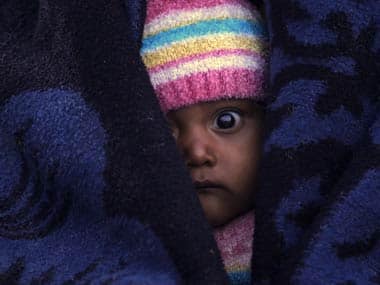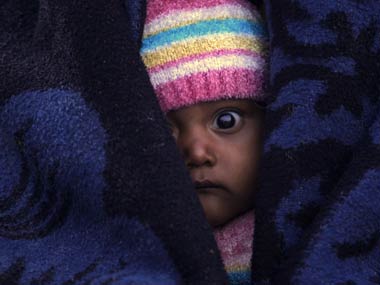Barely a month after the death of baby Afreen, who died after her father dislocated her neck and burnt her with cigarette butts, news of another battered baby girl has come to light. Baby Shireen from Indore was admitted to hospital, after her step father broke her arms and burnt her with beedis. The baby was brought to hospital by her mother Zarina. She said she had separated from her husband and was now living with a man named Wahid. He reportedly abused her children and forced her into prostitution. “He used to beat my daughter in my absence. He also broke her to arms. I thought the swelling could have been because of minor beatings, I didn’t know the baby’s arms were broken. One day when I went out for work, he rubbed bidi-buds into my baby’s body,” Zarina told NDTV. [caption id=“attachment_332512” align=“alignleft” width=“380” caption=“Representational image: Reuters”]
 [/caption] Times Now interviewed Wahid, who he denied that he had intended to hurt the baby. “My wife was not feeling well and she was not eating. So I beat her because she refused to eat. The child was next to her on the bed and she also got beaten as a result. I think her hand is a little broken”, he said. Baby Shireen is reportedly out of danger, but this latest incident brings into sharper focus, the ugly problem of India’s violence towards its women and girls. A 2011 report by the UN-DESA (United Nations Department of Economic and Social Affairs) shows that India has the highest rate of female child mortality among the 150 countries surveyed, which also included the LDRs (less developed regions). The report also points out that India has the largest gender-based difference in child mortality. A girl child in India, who is between the ages of 1 to 5 years, is 75 percent more likely to die than a boy in the same age category, the report added. This data appears more stark when read along with the recent data provided by the
Union home ministry
which indicated a drop in infant mortality rate in India to a national average of 47 to every 1,000 births. There has been an overall
drop in violence
in India too. What makes for these female deaths?
A 2011 report
from a study conducted jointly by the Indian Council of Medical Research and the Harvard School of Public Health, published in Archives of Pediatrics and Adolescent Medicine, established that girls under the age of five years in India were dying at an abnormally high rate because of the prevalence of domestic violence in their homes. In India, female infanticide has been systematically made part of the societal practices.
Each region has its well-established methods
to kill the female child which includes drowning the baby in a bucket of water, feeding her salt on burying her alive in an earthen pot. In India corporal punishment is still viewed as a normal practice, which makes it difficult for one to judge whether the violence going on in a neighbour’s home is a simple ‘punishment’ or child abuse. But more importantly, the monitoring system
fails at the very outset
, when the child is brought to the hospital: The key is to bring changes both at the societal as well as the legal level, and to improve ongoing monitoring of a girl child’s welfare, be it at the hospital or in the local anganwadi. A change in perception of a girl’s role in society backed by laws punishing perpetrators of child abuse are the only ways to make a difference.
[/caption] Times Now interviewed Wahid, who he denied that he had intended to hurt the baby. “My wife was not feeling well and she was not eating. So I beat her because she refused to eat. The child was next to her on the bed and she also got beaten as a result. I think her hand is a little broken”, he said. Baby Shireen is reportedly out of danger, but this latest incident brings into sharper focus, the ugly problem of India’s violence towards its women and girls. A 2011 report by the UN-DESA (United Nations Department of Economic and Social Affairs) shows that India has the highest rate of female child mortality among the 150 countries surveyed, which also included the LDRs (less developed regions). The report also points out that India has the largest gender-based difference in child mortality. A girl child in India, who is between the ages of 1 to 5 years, is 75 percent more likely to die than a boy in the same age category, the report added. This data appears more stark when read along with the recent data provided by the
Union home ministry
which indicated a drop in infant mortality rate in India to a national average of 47 to every 1,000 births. There has been an overall
drop in violence
in India too. What makes for these female deaths?
A 2011 report
from a study conducted jointly by the Indian Council of Medical Research and the Harvard School of Public Health, published in Archives of Pediatrics and Adolescent Medicine, established that girls under the age of five years in India were dying at an abnormally high rate because of the prevalence of domestic violence in their homes. In India, female infanticide has been systematically made part of the societal practices.
Each region has its well-established methods
to kill the female child which includes drowning the baby in a bucket of water, feeding her salt on burying her alive in an earthen pot. In India corporal punishment is still viewed as a normal practice, which makes it difficult for one to judge whether the violence going on in a neighbour’s home is a simple ‘punishment’ or child abuse. But more importantly, the monitoring system
fails at the very outset
, when the child is brought to the hospital: The key is to bring changes both at the societal as well as the legal level, and to improve ongoing monitoring of a girl child’s welfare, be it at the hospital or in the local anganwadi. A change in perception of a girl’s role in society backed by laws punishing perpetrators of child abuse are the only ways to make a difference.
Baby Shireen joins list of India's battered baby girls
FP Staff
• June 5, 2012, 11:26:47 IST
Barely a month after the death of baby Afreen, who died after her father dislocated her neck and burnt her with cigarette butts, news of another battered baby girl has come to light.
Advertisement
)
End of Article